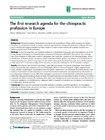| dc.contributor.author | Rubinstein, Sidney M | |
| dc.contributor.author | Bolton, Jennifer | |
| dc.contributor.author | Webb, Alexandra L | |
| dc.contributor.author | Hartvigsen, Jan | |
| dc.date.accessioned | 2019-02-21T16:48:29Z | |
| dc.date.available | 2019-02-21T16:48:29Z | |
| dc.date.issued | 2014 | |
| dc.identifier.citation | Rubinstein, S. M., Bolton, J., Webb, A. L. and Hartvigsen, J., 2014. The first research agenda for the chiropractic profession in Europe. Chiropractic and Manual Therapies, 22:9 https://doi.org/10.1186/2045-709X-22-9 | en |
| dc.identifier.issn | 2045-709X | |
| dc.identifier.uri | https://aecc.archive.knowledgearc.net/handle/123456789/56 | |
| dc.description | Available under License - Creative Commons Attribution: https://creativecommons.org/licenses/by/4.0/ | en |
| dc.description.abstract | Background: Research involving chiropractors is evolving and expanding in Europe while resources are limited. Therefore, we considered it timely to initiate a research agenda for the chiropractic profession in Europe. The aim was to identify and suggest priorities for future research in order to best channel the available resources and facilitate advancement of the profession.
Methods: In total, 60 academics and clinicians working in a chiropractic setting, and who had attended any of the annual European Chiropractors’ Union/European Academy of Chiropractic (ECU/EAC) Researchers’ Day meetings since their inception in 2008, were invited to participate. Data collection consisted of the following phases: phase 1 identification of themes; phase 2 consensus, which employed a Delphi process and allowed us to distil the list of research priorities; and phase 3 presentation of the results during both the Researchers’ Day and a plenary session of the annual ECU Convention in May 2013. In addition, results were distributed to all ECU member countries.
Results: The response rate was 42% from phase 1 and 68% from phase 2. In general, participants were middle-aged, male and had been awarded a Doctor of Philosophy (PhD) as well as chiropractic degree. Approximately equal numbers of participants had obtained their chiropractic degree from the UK/Europe and North America. The majority of participants worked primarily in an academic/research environment and approximately half worked in an independent institution. In total, 58% of the participants were from the UK and Denmark, collectively representing 44% of the chiropractors working in Europe. In total, 70 research priorities were identified, of which 19 reached consensus as priorities for future research. The following three items were thought to be most important: 1) cost-effectiveness/economic evaluations, 2) identification of subgroups likely to respond to treatment, and 3) initiation and promotion of collaborative research activities.
Conclusions: This is the first formal and systematic attempt to develop a research agenda for the chiropractic profession in Europe. Future discussion and study is necessary to determine whether the themes identified in this survey should be broadly implemented. | en |
| dc.language.iso | en | en |
| dc.publisher | Chiropractic and Manual Therapies | en |
| dc.title | The first research agenda for the chiropractic profession in Europe | en |
| dc.type | Article | en |
| dc.identifier.doi | https://doi.org/10.1186/2045-709X-22-9 | |
